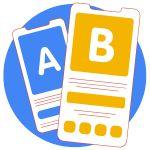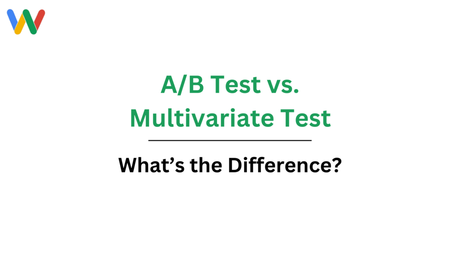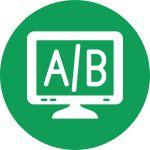Did you know you could boost your website’s performance without even spending a dime extra?
A/B testing helps you identify the best variant of almost every website element, including:
- The calls to action
- Design and interface
- Content
- Images
- Videos
And that’s just the tip of the iceberg! With A/B testing, you have the power to make data-driven decisions to improve your website’s conversion rates and overall user experience.
In this post, we’ll discuss how A/B testing and website optimization relate to each other.
By the end, you’ll know how to use A/B tests to boost engagement and conversions. You’re just one click away from unlocking the power of A/B testing and taking your website to the next level.
But first, let’s dive into the basics of A/B testing.
What is A/B Testing?
A/B testing involves pitting two variations of a website element against each other to see which one drives better results.
This can be anything from your homepage headline to a landing page’s call to action.
A/B testing is essentially a data-driven approach to website optimization.
How Does A/B Testing Work?
Let’s say you have a product page that’s getting decent traffic but not enough sales.
You want to see if changing the call to action will have any positive impact. And, you create a second CTA.
You can make the second CTA button more visible by adding a different background color.
Or, you can change the CTA copy, such as “Buy now”, “Add to cart”, etc.
An A/B test will give you the data for both CTAs, allowing you to identify the more click-worthy one.
A/B Testing vs. Multivariate Testing

In A/B testing, you test two variations of one element.
For instance, it can be a headline, a call to action, or an image.
A multivariate test, on the other hand, tests combinations of multiple variations simultaneously.
It can help you test combinations of headlines, CTAs, and images.
The first step is to create variations of each element you want to test.
Then, you split your website traffic and showcase different variations to each segment.
Lastly, you analyze the results and identify the combination that performs better.
Multivariate testing can be complex, so we’d suggest starting with A/B testing and keeping things simple in the beginning.
A/B Testing and Website Optimization: Elements to Test
You can use A/B testing to compare the results of entire pages. Or, you can test individual elements on a web page.
Here are the most important website elements to test.
Headlines
The headline of a web page is mostly the first thing someone sees after landing on it.
It decides whether a visitor will continue reading the rest of the content or bounce back.
A/B testing gives you actionable data on which headline variation resonates with your visitors more.
Calls to Action

An actionable CTA helps you convert your visitors into leads or customers.
However, creating a CTA that grabs attention and inspires action can be tricky.
When you’re not sure about the copy, color, size, and location of your CTA, A/B testing can help.
What you can do is create two variations of your CTA and send equal traffic to both of them.
Track your traffic and see which variation is more impactful.
Images and Videos
Images are generally more engaging than text, helping you keep visitors on your site for longer.
However, some perform better than others. How do you identify the right ones? By conducting A/B tests.
Videos can be even more engaging, helping you increase the time an average user spends on your site.
However, should you use autoplay or let viewers play your videos manually?
Maybe you want to test two different types of videos on the same topic.
A/B testing can help you make data-backed decisions for all those scenarios.
Content
Powerful content drives engagement and performs well on search engines.
You can use A/B testing to analyze different parts of a piece of content, including its:
- Length
- Structure
- Types (Infographics, videos, blog posts, etc.)
Contact Forms
If you want visitors to contact you through a form, it’s important to make sure you only collect relevant information.
Sometimes, by asking for too much information, website owners end up losing leads. Other times, a very simple form may let too many unqualified leads or spammers through.
You can test different variations of your contact form to know which one drives the most action.
User Experience (UX)

User Experience, or UX, is a crucial aspect of website design. It refers to the overall experience that a user has while interacting with a website. This includes everything from the layout and structure of the site, to how easy it is to navigate and find information. A well-designed UX can greatly impact your website’s success. It can lead to increased conversions, reduced bounce rates, improved engagement with visitors, and ultimately boost your return on investment (ROI).
Testing different UX elements will help you:
- Improve conversions
- Reduce bounce rate
- Improve engagement
- Boost your ROI
You May Also Like: The Importance of Accessibility in Website Design
A/B Testing and Website Optimization: Step-by-Step
A/B testing is a powerful way to make sure your marketing strategies are generating the highest possible ROI for you.
However, creating and implementing an effective A/B testing strategy can be daunting as it involves a lot of planning. Here’s how you can use A/B testing to optimize your website step-by-step.
Define Your Hypothesis
Start by defining what you want to test on your website. For instance, you might think changing the copy of your CTA on a landing page will improve conversions. Or maybe you want to test the placement of an image on your homepage. Whatever it may be, clearly define your hypothesis before starting.
Set Up Your A/B Testing Tool
There are several tools available to help you conduct A/B testing on your website. Some popular options include Zoho PageSense, Optimizely, and VWO. Before you can start testing, you’ll need to set up your chosen tool and integrate it into your website’s code.
Identify Your Variables
The second step is to define your variables. In A/B testing, you have to select one variable at a time. For instance, you can’t test a CTA and an image simultaneously.
Choose Your Metrics
Once you know your variable, it’ll be easy to choose the target metric you should track. For instance, if you’re testing a CTA button with different background colors, you’ll want to measure your click-through rate. If you’re testing out a new form layout, you may want to track form submissions.
Choose Sample Size
Your sample size should be big enough to give you meaningful data. Decide on the number of website visitors you will be conducting the A/B test on.
For instance, before drawing any conclusions, you may want to let your web page attract at least 1000 visitors.
Run and Analyze Your A/B Test
When everything is ready, it’s time to run your A/B test with a tool. Make sure both your test variations are receiving an equal amount of traffic.
Compare the results from both variations and you’ll have the winner. However, if the results aren’t conclusive, consider running more tests.
Keep monitoring your results to make sure your website is generating the desired ROI.
How A/B Testing and SEO Interact
At Webology, one of our core services is SEO and we often get asked about how A/B testing can affect it.
While A/B testing primarily focuses on improving conversion rates and user experience, it also has an impact on SEO. This is because search engines value a positive user experience and are more likely to rank websites higher if they have a low bounce rate and high engagement. Keep in mind that this is a minor ranking factor and authority is still the most important thing for increasing organic traffic.
But by running A/B tests, you are constantly refining and optimizing your website for better user experience. This leads to a longer session duration, lower bounce rates, and ultimately, better conversions and a slightly higher chance of ranking well on search engine results pages (SERPs).
Additionally, by conducting an A/B test with different variations of your webpage, you are essentially creating new content for search engines to crawl. This can potentially lead to more indexed pages and improved visibility due to the ‘freshness’ algorithm search engines are known to use.
A/B Testing and Website Optimization: Conclusion
A/B testing is a perfect way to identify high-performing website elements such as calls to action, headlines, copy, images, and more.
The process starts with selecting what you want to test. If it’s a CTA, create a second variant and send an equal amount of traffic to both.
If the second variant generates more clicks, you’ve got your winner. However, make sure your sample size is big enough. Also, don’t draw conclusions based on insignificant improvements in results. We recommend at least 1,000 visits per variant.
Furthermore, A/B testing is not a one-time thing. It should be an ongoing process to continuously optimize and improve your website’s performance.
You May Also Like: How to Build a Website with SEO in Mind
